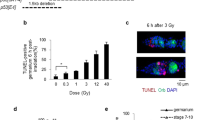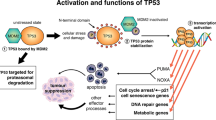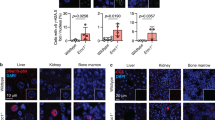Abstract
Testicular teratocarcinomas never contain p53 gene mutations even though these tumors express high levels of nuclear p53 protein. We have characterized two murine teratocarcinoma cell lines and find no evidence that endogenous p53–regulated genes are correspondingly upregulated. Differentiation of these teratocarcinoma cells with retinoic acid results in a marked decrease in p53 protein levels but is accompanied by a marked increase in p53–mediated transcriptional activity. Together these results support the hypothesis that the p53 protein in undifferentiated teratocarcinoma cells is transcriptionally inactive and accounts for the lack of selection for p53 gene mutations in this tumor type. These teratocarcinoma cells undergo p53–mediated apoptosis in response to DNA damage, which may explain the routine cures of human testicular tumors with combination chemotherapy.
This is a preview of subscription content, access via your institution
Access options
Subscribe to this journal
Receive 12 print issues and online access
$209.00 per year
only $17.42 per issue
Buy this article
- Purchase on Springer Link
- Instant access to full article PDF
Prices may be subject to local taxes which are calculated during checkout
Similar content being viewed by others
References
Pottern, L. & Goedert, J. Principles and Management of Testicular Cancer (ed. Javadpour, N.) 108–119 (Thieme, New York, 1986).
Champlin, R. & Gale, R. Acute myelogenous leukemia: Recent advances in therapy. Blood 69 1551–1562 (1987).
Harris, C.C. & Hollstein, M. Clinical implications of the p53 tumor-suppressor gene. NewEngl. J. Med. 329, 1318–1327 (1993).
Levine, A.J. et al The role of the p53 tumor suppressor gene in tumorigenesis. Br. J. Cancer 69, 409–416 (1994).
Oren, M., Reich, N.C. & Levine, A.J. Regulation of the cellular p53 tumor antigen in teratocarcinoma cells and their differentiated progeny. Mol. Cell. Biol. 2 443–449 (1982).
Bartkova, J. et al. p53 protein alterations in human testicular cancer including pre-invasive intratubular germ-cell neoplasia. Int. J. Cancer 49, 196–202 (1991).
Lewis, D., Sesterhenn, I., McCarthy, W. & Moul, J. Immunohistochemical expression of p53 tumor suppressor gene protein in adult germ cell testis tumors: Clinical correlation in stage I disease. J. Urol. 152, 418–423 (1994).
Riou, G. et al. The p53 and mdm-2 genes in human testicular germ-cell tumors. Mol Carrinog. 12, 124–131 (1995).
Heimdal, K. et al. No germline TP3 mutations detected in familial and bilateral testicular cancers. Genes Chromosom. Cancer 6, 92–97 (1993).
Peng, H.Q. et al. Mutations of the p53 gene do not occur in testis cancer. Cancer Res. 53, 3574–3578 (1993).
Murty, V.V.V.S. et al. Allelic loss and somatic differentiation in human male germ cell tumors. Oncogene 9, 2245–2251 (1994).
Schenkman, N.S. et al. Increased p53 protein does not correlate to p53 gene mutations in microdissected human testicular germ cell tumors. J. UroL 154, 617–621 (1995).
Pennica, D. et al. The amino acid sequence of murine p53 determined from a cDNA clone. Virology 134, 477–483 (1984).
Reich, N.C., Oren, M. & Levine, A.J. Two distinct mechanisms regulate the levels of a cellular tumor antigen, p53. Mol. Cell. Biol. 3, 2143–2150 (1983).
Momand, J., Zambetti, G.P., Olson, D.C., George, D. & Levine, A.J. The mdm-2 oncogene product forms a complex with the p53 protein and inhibits p53 mediated transactivation. Cell 69, 1237–1245 (1992).
Oliner, J.D., Kinzler, K.W., Meltzer, P.S., George, D. & Vogelstein, B. Amplification of a gene encoding a p53-associated protein in human sarcomas. Nature 358, 80–83 (1992).
Finlay, C.A. The mdm-2 oncogene can overcome wild-type p53 suppression of transformed cell growth. Mol Cell. Biol. 13, 301–306 (1993).
Fakharzadeh, S.S., Trusko, S.P. & George, D.L. Tumorigenic potential associated with enhanced expression of a gene that is amplified in a mouse tumor cell line. EMBO J. 10, 1565–1569 (1991).
Gannon, J.V., Greaves, R., Iggo, R. & Lane, D.P. Activating mutations in p53 produce common conformational effects: A monoclonal antibody specific for the mutant form. EMBO J. 9, 1595–1602 (1990).
Olson, D. et al. Identification and characterization of multiple mdm-2 proteins and mdm-2-p53 protein complexes. Oncogene 8, 2353–2360 (1993).
Barak, Y., Juven, T., Haffner, R. & Oren, M. mdm2 expression is induced by wild type p53 activity. EMBO J. 12, 461–468 (1993).
Haines, D.S., Landers, J.E., Engle, L.J. & George, D.L. Physical and functional interaction between wild-type p53 and mdm-2 proteins. Mol. Cell. Biol. 14, 1171–1178 (1994).
Michalovitz, D., Halevy, O. & Oren, M. Conditional inhibition of transformation and of cell proliferation by a temperature-sensitive mutant of p53. Cell 62, 671–680 (1990).
Wu, X., Bayle, J.H., Olson, D. & Levine, A.J. The p53-mdm-2 autoregulatory feedback loop. Genes Dev. 7, 1126–1132 (1993).
Kastan, M.B., Onyekwere, O., Sidransky, D., Vogelstein, B. & Craig, R.W. Participation of p53 protein in the cellular response to DNA damage. Cancer Res. 51, 6304–6311 (1991).
El-Deiry, W.S. et al. WAF1/CIP1 is induced in p53-mediated G: arrest and apop-tosis. Cancer Res. 54, 1169–1174 (1994).
Perry, M.E., Piette, J., Zawadzki, J., Harvey, D. & Levine, A.J. The mdm-2 gene is induced in response to UV light in a p53-dependent manner. Proc. Natl. Acad. Sci.USA 90, 11623–11627 (1993).
Shaw, P. et al. Induction of apoptosis by wild-type p53 in a human colon tumor-derived cell line. Proc. Natl. Acad. Sci. USA 89, 4495–4499 (1992).
Yonish-Rouach, E. et al. Wild-type p53 induces apoptosis of myeloid leukaemic cells that is inhibited by interleukin-6. Nature 352, 345–347 (1991).
Strickland, S., Smith, K. & Marotti, K. Hormonal induction of differentiation in teratocarcinoma stem cells: Generation of parietal endoderm by retinoic acid and dibutyryl cAMP. Cell 21 (1980).
Lucje-Huhle, C. & Herrlich, P. Retionic-acid-induced differentiation prevents gene amplification in teratocarcinoma stem cells. Int. J. Cancer 47, 461–465 (1991).
Livingstone, L.R. et al. Altered cell cycle arrest and gene amplification potential accompany loss of wild-type p53. Cell 70, 923–935 (1992).
Harvey, M., McArther, M., Montgomery, C., Bradley, A. & Donehower, L. Genetic background alters the spectrum of tumors that develop in p53-deficient mice. FASEB J. 7, 938–943 (1993).
Rotter, V. et al. Mice with reduced levels of p53 protein exhibit the testicular giant-cell degenerative syndrome. Proc. Natl Acad. Sci. USA 90, 9075–9079 (1993).
Rao, L. et al. The adenovirus El A proteins induce apoptosis which is inherited by the E1B 19 Kd and Bel proteins. Proc. Natl Acad. Sci. USA 89, 7742–7746 (1992).
Hupp, T., Meek, D., Midgley, C.A. & Lane, D. Regulation of the specific DNA binding function of p53. Cell 71, 875–886 (1992).
Thut, C.J., Chen, J.L., Klemin, R. & Tjian, R. p53 transcriptional activation mediated by coactivators TAFII40 and TAFII60. Science 267, 100–104 (1995).
Lu, H. & Levine, A.J. Human TAF-31 is a transcriptional coactivation of the p53 protein. Proc. Natl. Acad. Sci. USA 92, 5154 (1995).
Clarke, A.R. et al Thymocyte apoptosis induced by p53-dependent and independent pathways. Nature 362, 849–852 (1993).
Lotem, J. & Sachs, L. Hematopoietic cells from mice deficient in wild-type p53 are more resistant to induction of apoptosis by some agents. Blood 82, 1092–1096 (1993).
Lowe, S.W., Schmitt, E.M., Smith, S.W., Osborne, B.A. & Jacks, T. p53 is required for radiation induced apoptosis in mouse thymocytes. Nature 362, 847–849 (1993).
Evan, G.I. et al. Induction of apoptosis in n'broblasts by c-myc protein. Cell 69, 119–128 (1992).
Hermeking, H. & Eick, D. Mediation of c-Myc-induced apoptosis by p53. Science 265, 2091–2093 (1994).
Debbas, M. & White, E. Wild-type p53 mediates apoptosis by E1A which is inhibited by E1B. Genes Dev. 7, 546–554 (1993).
Wu, X. & Levine, A.J. p53 and E2F-1 cooperate to mediate apoptosis. Proc. Natl. Acad. Sci. USA 91, 3602–3606 (1994).
Canman, C., Gilmer, T., Coutts, S. & Kastan, M. Growth factor modulation of p53-mediated growth arrest versus apoptosis. Genes Dev. 9, 600–611 (1995).
Campisi, J., Gray, H., Pardee, A., Dean, M. & Sonnenshein, G. Cell cycle control of c-myc but not c-ras expression is lost following transformation. Cell 36, 241–247 (1984).
Imperiaie, M., Kao, H.-T., Feldman, L., Nevins, J. & Strickland, S. Common control of the heat shock gene and early adenovirus-genes: Evidence for a cellular elA-like activity. Mol. Cell. Biol 4, 867–874 (1984).
Strohmeyer, T. et al. Correlation between retinoblastoma gene expression and differentiation in human testicular tumors. Proc. Natl. Acad. Sci. USA 88, 6662–6666 (1991).
Hen, R., Borrelli, E., Fromental, D., Sassone-Corsi, P. & Chambon, P. A mutated polyoma virus enhancer which is active in undifferentiated embryonal carcinoma cells is not repressed by adenovirus-2 E1A products. Nature 321, 249–251 (1986).
Slack, R.S. et al Cells differentiating into neuroectoderm undergo apoptosis in the absence of functional retinoblastoma family proteins. J. Cell Biol 129, 779–788 (1995).
Langley, R., Palayoor, S., Coleman, C., Bump, E. Radiation-induced apoptosis in F9 teratocarcinoma cells. Int. J. Radiat. Biol 65, 605–610 (1994).
Schmid, P., Lorenz, A., Hameister, H. & Montenarh, M. Expression of p53 during mouse embryogenesis. Development 113, 857–865 (1991).
Mora, P., Chandrasekaran, K. & McFarland, V. An embryo protein induced by SV40 virus transformation of mouse cells. Nature 288, 722–724 (1980).
Nicol, C., Harrison, M., Laposa, G., Gimelshtein, I. & Wells, P. A teratologic suppressor role for pS3 in benzo[ajpyrene-treated transgenic p53-deficient mice. Nature Genet. 10, 181–187 (1995).
Marechal, V., Elenbaas, B., Piette, J., Nicolas, J.-C. & Levine, A.J. The ribosomal L5 protein is associated with mdm-2 and mdm-2-p53 complexes. Mol. Cell. Biol. 14, 7414–7420 (1994).
Chomczynski, P. & Sacchi, N. Single-step method of RNA isolation by acid guanidium thiocyanate-phenol-chloroform extraction. Anal. Biochem. 162, 156–159 (1987).
Author information
Authors and Affiliations
Rights and permissions
About this article
Cite this article
Lutzker, S., Levine, A. A functionally inactive p53 protein interatocarcinoma cells is activated by either DNA damage or cellular differentiation. Nat Med 2, 804–810 (1996). https://doi.org/10.1038/nm0796-804
Received:
Accepted:
Published:
Issue Date:
DOI: https://doi.org/10.1038/nm0796-804
This article is cited by
-
Exploring the genetic and molecular basis of differences in multiple myeloma of individuals of African and European descent
Cell Death & Differentiation (2024)
-
Current view of liver cancer cell-of-origin and proposed mechanisms precluding its proper determination
Cancer Cell International (2023)
-
Disruption of the MDM2–p53 interaction strongly potentiates p53-dependent apoptosis in cisplatin-resistant human testicular carcinoma cells via the Fas/FasL pathway
Cell Death & Disease (2011)
-
Ablation of a peptidyl prolyl isomerase Pin1 from p53-null mice accelerated thymic hyperplasia by increasing the level of the intracellular form of Notch1
Oncogene (2007)
-
DNA damage response mediators MDC1 and 53BP1: constitutive activation and aberrant loss in breast and lung cancer, but not in testicular germ cell tumours
Oncogene (2007)



